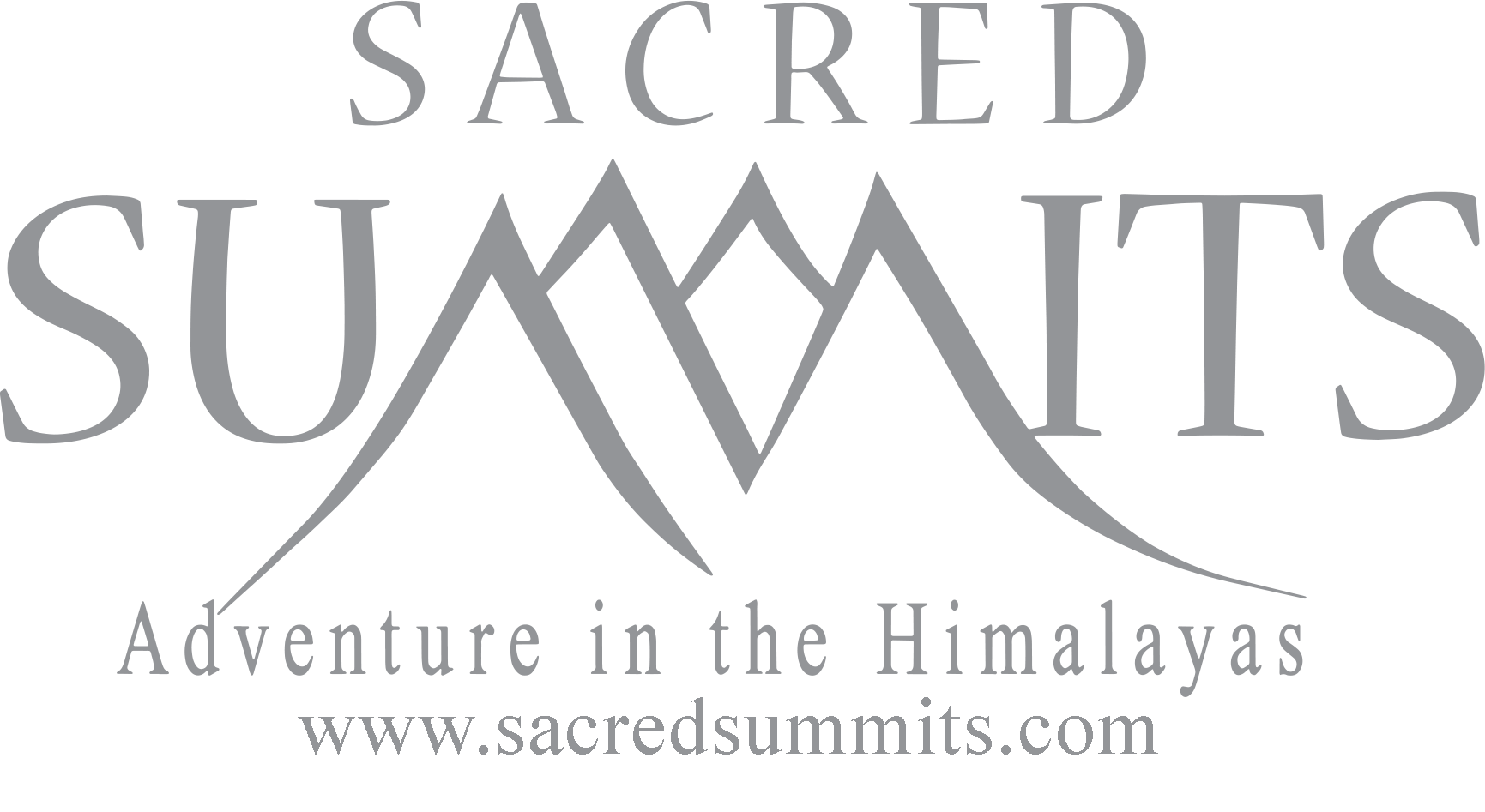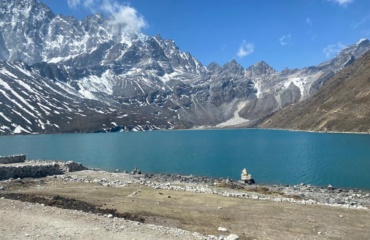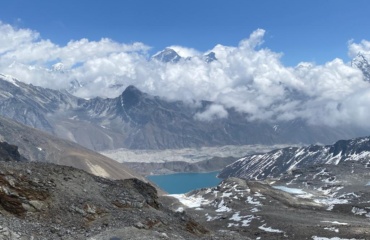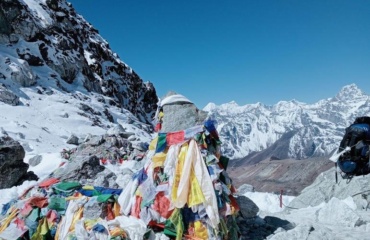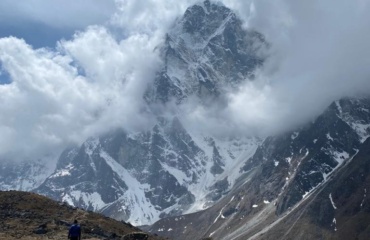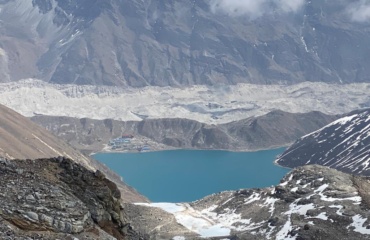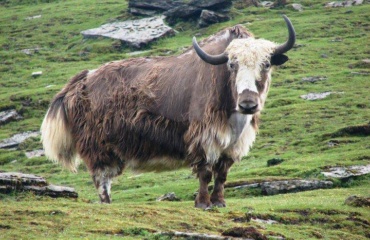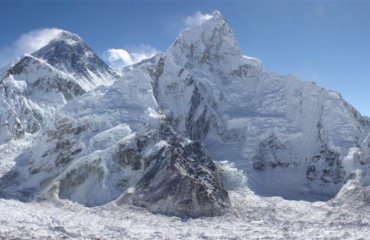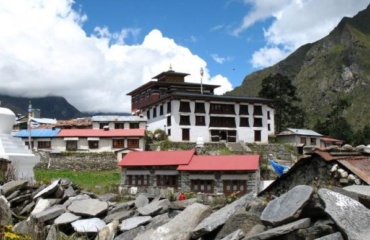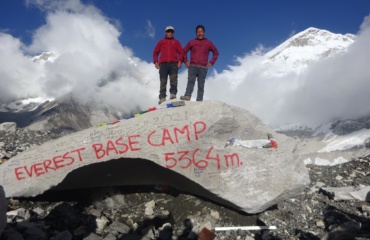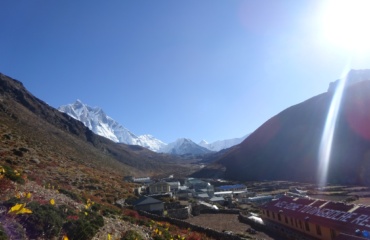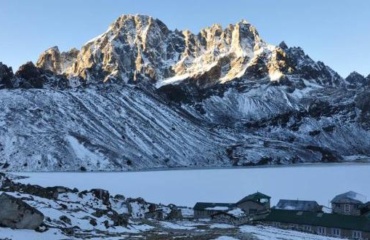GOKYO, CHO LA PASS & EVEREST BASE CAMP TREK
Gokyo, Chola Pass, and Everest Base Camp are three remarkable destinations in the Everest region of Nepal, each offering its own unique experience to trekkers and adventurers.
Gokyo is a picturesque valley known for its tranquil turquoise lakes, collectively called the Gokyo Lakes.
Chola Pass, also known as Cho La, is a high-altitude mountain pass situated at an elevation of approximately 5,420 meters (17,782 feet). It lies along the route connecting Gokyo Valley with Everest Base Camp.
Everest Base Camp, located at an altitude of about 5,364 meters (17,598 feet), is the ultimate destination for mountaineers aiming to conquer the world’s highest peak, Mount Everest. It serves as a temporary settlement for climbers during their acclimatization process before attempting the summit.
Combining Gokyo, Chola Pass, and Everest Base Camp into a single trek is a thrilling and challenging adventure. The journey takes trekkers through breathtaking landscapes, including serene lakes, towering peaks, ancient glaciers, and remote Sherpa villages. It requires physical fitness, mental endurance, and proper preparation. However, the sense of accomplishment and the unforgettable memories created along the way make it a truly remarkable experience for those seeking the ultimate Himalayan adventure.
-
Reviews 0 Reviews0/5
-
Vacation Style Holiday TypeTrekking
-
Activity Level Strenuous
-
Group Size Medium Group
Gokyo Lake is a stunning collection of high-altitude lakes located in the Everest region of Nepal. Situated at an elevation of approximately 4,700 meters (15,420 feet), these glacial lakes are nestled amidst the majestic Himalayas, making them one of the most enchanting destinations for trekkers and adventurers.
Gokyo Lake is a cluster of six lakes, known as the Gokyo Lakes, and is considered sacred by both the Sherpa people, who inhabit the region, and the Hindu and Buddhist communities in Nepal. The lakes are known for their pristine turquoise waters, which are fed by the melting glaciers of the Ngozumpa Glacier, the longest glacier in the Himalayas. The largest of the Gokyo Lakes is called Dudh Pokhari, meaning “Milk Lake,” due to its milky appearance caused by the glacial sediments in the water.
Chola Pass is one of the most fashionable treks in the Everest region. This trek links Everest Base Camp and Gokyo Valley with adventurous Chola Pass crossing over 5417 meter mountain pass. It covers not only Everest Base Camp but also Lukla, Namche Bazar, Tengboche as whole Solukhumbu (Distric) and some nice peaks (like Gokyo Ri or Kala Patthar)
The Everest Base Camp Trek takes one to the foothills of the mightiest of the mountains in the world. En-route, traverse through rhododendron and pine forests, rivers, Sherpa villages and Buddhist Monasteries from temperate to snow line regions. The Himalayas are best seen on this trek as one traces the main route through the Khumbu region from the Sherpa town of Namche Bazaar. Trekkers get a close view of the world’s greatest mountains, Everest, Lhotse, Nuptse, Thamserku, Tawache and others.
Located in the eastern half of Nepal, the Everest region offers a wide range of trekking experiences. From the well-developed trail to Everest base camp to treks in remote semi-wilderness areas, there is a choice to suit all-corners. The most frequented part of the region is located in Solukhumbu district, the home of the legendary Sherpa’s. The northern part of the district (Khumbu) is encompassed in the Everest National Park, which was established to protect the fragile environment of the alpine region.
- Arrival transfer from airport to hotel in a private deluxe car accompanied by a member of Sacred summits P.LTD
- Welcome Dinner and Farewell Dinner with transfer and accompanied by a member of Sacred summits P.LTD
- 4 nights stay at Hotel Manaslu (3 star) OR Similar in Kathmandu on bed and breakfast basis and inclusive of all taxes (presently 24.3%)
- Full days sightseeing tour of Pashupatinath Temple + Boudhanath Stupa & Swayambhunath in a private deluxe car accompanied by a knowledgeable English speaking guide.
- Transfer from Kathmandu to Ramechap (Pre Trek) in a private a/c car accompanied by a Trek Guide/Sirdar.
- 01 night stay at Freedom Resort OR Similar in Ramechap on bed and breakfast basis and inclusive of all taxes (presently 24.3%)
- Airfare for the sector Ramechap / Lukla / Ramechap
- Airfare for the guide for the sector Kathmandu / Lukla / Kathmandu inclusive of all the airport taxes.
- Khumbu Development Fee of USD 33.00 per person. (Subjected to change without prior notice)
- Package Trek (Full Board on Trek) includes 16 Nights / 17 Days trek in the Everest/ Gokyo / Khumbu Region inclusive of accommodations in a standard Lodges / Guest houses (Rooms with attached baths will be provided as per availability and all meals (breakfast + Lunch + Dinner) prepared by the cook at the Tea Houses / Lodges from the menu upon discussion with the group’s preference and the things that are available.
- Services of an experienced (knowledgeable and trained in high altitude and first aid) Trek Sirdar /Escort/Guide from Sacred Summits (P) Ltd.
- Services of locally hired porter to carry the luggage during the trek (1 porter carry’s 25 kilograms)
- All expenses for the guide and support staff including their daily allowances which includes their meals and accommodations as well.
- Transfer from Ramechap to Kathmandu (Post Trek) in a private a/c car accompanied by a Trek Guide/Sirdar.
- Contribution to Guide and Porter Insurance
- A comprehensive medical kit
- Final departure transfer from hotel to airport in a private deluxe car accompanied by a member of Sacred Summits (P) Ltd
- Government taxes and tolls and entrance fees where applicable.
- International Airfares.
- Nepal Visa fees (If applicable).
- Covid-19 Related PCR TEST AND Insurance
- Meals (Lunch & Dinner) while the guest stay at hotels in Kathmandu. (Except Breakfast and Welcome and Farewell Dinner)
- Items of a personal nature such as boiled water, mineral water, bar bills telephone calls, laundry, extra mileage and any extra costs incurred due to natural calamities, flight delays etc.
- Personal medication
- Any kind of Insurance (Personal Insurance/Third party insurance /Covid Insurance/ Insurance for or against accidents, loss of life, theft etc).
- Costs incurred due to cancellation of flights, altitude sickness or unforeseen circumstances (riots, natural calamities etc) and situations beyond the control of Sacred Summits (P) Ltd.
- Tips for the trek staff (guide + Porter)
- Any item not mentioned in the above ‘cost includes’.
- Day 01 Arrive Kathmandu (1370 M)
- Day 02 Full day sightseeing tour in Kathmandu
- Day 03 Drive Kathmandu to FREEDOM RESORT (164kms/4hrs)
- Day 04 Fly from Ramechap to Lukla (2880m) and trek to Phakding (2652m)
- Day 05 Trek from Phakding to Namche Bazaar (3440 m)
- Day 06 Rest and acclimatization at Namche Bazaar
- Day 07 Trek from Namche to Phortse Drengka (3,675 m) Via Mon La (3,973 m)
- Day 08 Trek from Phortse Drengka to Dole (4,040 m)
- Day 09 Trek from Dole to Machermo (4,400 m)
- Day 10 Trek from Machermo to Gokyo (4750 m)
- Day 11 Excursion to Gokyo RI (5,483 m) and back
- Day 12 Trek from Gokyo to Chyugima (5,040 m)
- Day 13 Trek from Chyugima to Dzongla (4843 m) via Chola Pass(5595m)
- Day 14 Trek from Dzongla to Lobuche (4,931 m
- Day 15 Trek from Lobuche to Gorakshep (5180m) / Everest Base Camp (5360m) and Back
- Day 16 Early morning excursion to - Kalaphattar (5545 m) & descend to Periche (4240m)
- Day 17 Trek from Pheriche to Namche Bazaar (3400m)
- Day 18 Trek from Namche (3400 m) to Monjo
- Day 19 Trek from Monjo to Lukla (2880 M)
- Day 20 Fly Lukla to Ramechap and Drive Back to kathmandu
- Day 21 Day free for other activities.
- Day 22 Final Departure

